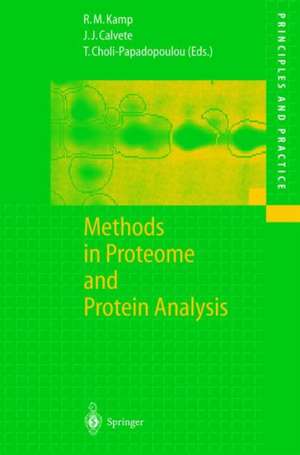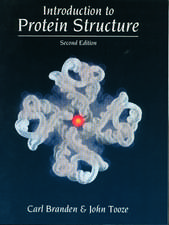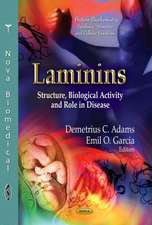Methods in Proteome and Protein Analysis: Principles and Practice
Editat de Roza Maria Kamp, Juan J. Calvete, Theodora Choli-Papadopoulouen Limba Engleză Hardback – 23 ian 2004
Major topics include: protein and peptide sample preparation and separation; new reagent for protein sequence analysis; mass spectrometry in protein research; analysis of posttranslational modification; protein-protein interaction using MALDI-MS; manipulation of genome or functional compositon trap; structure-function correlation study using optical biosensors of microcolorimetrical techniques; structural proteomics as NMR or fluorescence polarization study; the classification and prediction of structure or functional sites; in silico analysis of proteins and proteomes; increasing throughput and data quality for proteomics.
| Toate formatele și edițiile | Preț | Express |
|---|---|---|
| Paperback (1) | 1199.65 lei 38-44 zile | |
| Springer Berlin, Heidelberg – 5 dec 2010 | 1199.65 lei 38-44 zile | |
| Hardback (1) | 1398.00 lei 43-57 zile | |
| Springer Berlin, Heidelberg – 23 ian 2004 | 1398.00 lei 43-57 zile |
Din seria Principles and Practice
- 15%
 Preț: 638.76 lei
Preț: 638.76 lei - 18%
 Preț: 946.55 lei
Preț: 946.55 lei - 15%
 Preț: 637.78 lei
Preț: 637.78 lei - 18%
 Preț: 1224.36 lei
Preț: 1224.36 lei - 18%
 Preț: 1229.40 lei
Preț: 1229.40 lei - 5%
 Preț: 362.88 lei
Preț: 362.88 lei - 18%
 Preț: 1209.52 lei
Preț: 1209.52 lei - 18%
 Preț: 953.03 lei
Preț: 953.03 lei - 15%
 Preț: 646.94 lei
Preț: 646.94 lei - 15%
 Preț: 644.95 lei
Preț: 644.95 lei - 5%
 Preț: 1104.68 lei
Preț: 1104.68 lei - 18%
 Preț: 1545.75 lei
Preț: 1545.75 lei - 15%
 Preț: 639.41 lei
Preț: 639.41 lei - 5%
 Preț: 710.06 lei
Preț: 710.06 lei - 18%
 Preț: 952.89 lei
Preț: 952.89 lei
Preț: 1398.00 lei
Preț vechi: 1704.87 lei
-18% Nou
Puncte Express: 2097
Preț estimativ în valută:
267.50€ • 280.05$ • 221.34£
267.50€ • 280.05$ • 221.34£
Carte tipărită la comandă
Livrare economică 07-21 aprilie
Preluare comenzi: 021 569.72.76
Specificații
ISBN-13: 9783540202226
ISBN-10: 3540202226
Pagini: 440
Ilustrații: XXXII, 404 p.
Dimensiuni: 155 x 235 x 29 mm
Greutate: 0.93 kg
Ediția:2004
Editura: Springer Berlin, Heidelberg
Colecția Springer
Seria Principles and Practice
Locul publicării:Berlin, Heidelberg, Germany
ISBN-10: 3540202226
Pagini: 440
Ilustrații: XXXII, 404 p.
Dimensiuni: 155 x 235 x 29 mm
Greutate: 0.93 kg
Ediția:2004
Editura: Springer Berlin, Heidelberg
Colecția Springer
Seria Principles and Practice
Locul publicării:Berlin, Heidelberg, Germany
Public țintă
ResearchCuprins
1 Helix-Helix Packing Between Transmembrane Fragments.- 2 Mobility Studies in Proteins by 15N Nuclear Magnetic Resonance: Rusticyanin as an Example.- 3 Structure and Dynamics of Proteins in Crowded Media: A Time-Resolved Fluorescence Polarization Study.- 4 Analyses of Wheat Seed Proteome: Exploring Protein—Protein Interactions by Manipulating Genome Composition.- 5 Modification-Specific Proteomic Strategy for Identification of Glycosyl-Phosphatidylinositol Anchored Membrane Proteins.- 6 Diocleinae Lectins: Clues to Delineate Structure/Function Correlations.- 7 The Contribution of Optical Biosensors to the Analysis of Structure-Function Relationships in Proteins.- 8 The Use of Protein—Protein Interaction Networks for Genome-Wide Protein Function Comparisons and Predictions.- 9 Probing Ribosomal Proteins Capable of Interacting with Polyamines.- 10 Applications of Optical Biosensors to Structure-Function Studies on the EGF/EGF Receptor System.- 11 The Functional Interaction Trap: A Novel Strategy to Study Specific Protein-Protein Interactions.- 12 Analysis of Protein-Protein Interactions in Complex Biological Samples by MALDI TOF MS. Feasibility and Use of the Intensity-Fading (IF-) Approach.- 13 Accelerator Mass Spectrometry in Protein Analysis.- 14 The Use of Micro calorimetric Techniques to Study the Structure and Function of the Transferrin Receptor from Neisseria meningitidis.- 15 The Quantitative Advantages of an Internal Standard in Multiplexing 2D Electrophoresis.- 16 Genetic Engineering of Bacterial and Eukaryotic Ribosomal Proteins for Investigation on Elongation Arrest of Nascent Polypeptides and Cell Differentiation.- 17 MALDI-MS Analysis of Peptides Modified with Photolabile Arylazido Groups.- 18 A New Edman-Type Reagent for High Sensitive ProteinSequencing.- 19 Amino Acid Sequencing of Sulfonic Acid-Labeled Tryptic Peptides Using Post-Source Decay and Quadratic Field MALDI-ToF Mass Spectrometry.- 20 Separation of Peptides and Amino Acids using High Performance Capillary Electrophoresis.- 21 InterPro and Proteome Analysis — In silico Analysis of Proteins and Proteomes.- 22 Prediction of Functional Sites in Proteins by Evolutionary Methods.- 23 Extracting and Searching for Structural Information: A Multiresolution Approach.- 24 Peak Erazor: A Windows-Based Programme for Improving Peptide Mass Searches.- 25 Increasing Throughput and Data Quality for Proteomics.
Textul de pe ultima copertă
Following the succesful publication of "Proteome and Protein Analysis" in 2000, which was based on a former MPSA (Methods in Protein Structure Analysis) conference, "Methods in Proteome and Protein Analysis" presents the most interesting papers from the 14th MPSA meeting.
Selected contributions discuss the latest techniques and approaches for analysing protein and proteome structures. Major topics include:
protein and peptide sample preparation and separation new reagent for protein sequence analysis
mass spectrometry in protein research
analysis of posttranslational modification
protein-protein interaction using MALDI-MS
manipulation of genome or functional compositon trap
structure-function correlation study using optical biosensors of microcolorimetrical techniques
structural proteomics as NMR or fluorescence polarization study
the classification and prediction of structure or functional sites
in silico analysis of proteins and proteomes
increasing throughput and data quality for proteomics
Selected contributions discuss the latest techniques and approaches for analysing protein and proteome structures. Major topics include:
protein and peptide sample preparation and separation new reagent for protein sequence analysis
mass spectrometry in protein research
analysis of posttranslational modification
protein-protein interaction using MALDI-MS
manipulation of genome or functional compositon trap
structure-function correlation study using optical biosensors of microcolorimetrical techniques
structural proteomics as NMR or fluorescence polarization study
the classification and prediction of structure or functional sites
in silico analysis of proteins and proteomes
increasing throughput and data quality for proteomics
Caracteristici
New edition" of the succesful publication "Proteome and Protein Analysis" (Kamp, Kyriakidis, Choli-Papadopoulou Eds.) An overview on the latest techniques and experimental approaches in protein sciences With contributions by authors from academic and industrial research laboratories Includes supplementary material: sn.pub/extras













